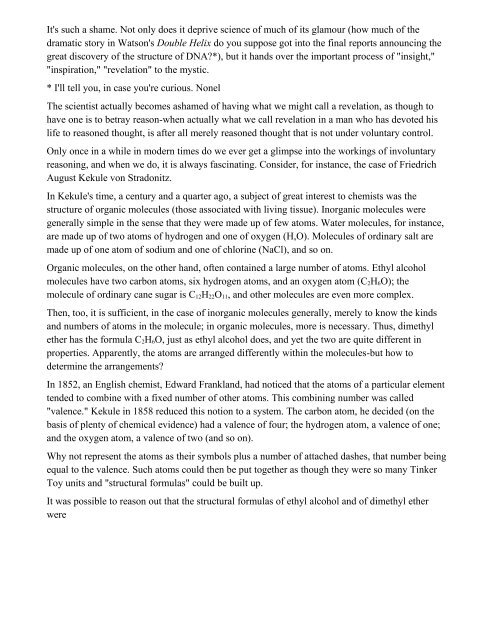The-Eureka-Phenomenon-by-Isaac-Asimov
The-Eureka-Phenomenon-by-Isaac-Asimov
The-Eureka-Phenomenon-by-Isaac-Asimov
Create successful ePaper yourself
Turn your PDF publications into a flip-book with our unique Google optimized e-Paper software.
It's such a shame. Not only does it deprive science of much of its glamour (how much of the<br />
dramatic story in Watson's Double Helix do you suppose got into the final reports announcing the<br />
great discovery of the structure of DNA?*), but it hands over the important process of "insight,"<br />
"inspiration," "revelation" to the mystic.<br />
* I'll tell you, in case you're curious. Nonel<br />
<strong>The</strong> scientist actually becomes ashamed of having what we might call a revelation, as though to<br />
have one is to betray reason-when actually what we call revelation in a man who has devoted his<br />
life to reasoned thought, is after all merely reasoned thought that is not under voluntary control.<br />
Only once in a while in modern times do we ever get a glimpse into the workings of involuntary<br />
reasoning, and when we do, it is always fascinating. Consider, for instance, the case of Friedrich<br />
August Kekule von Stradonitz.<br />
In KekuIe's time, a century and a quarter ago, a subject of great interest to chemists was the<br />
structure of organic molecules (those associated with living tissue). Inorganic molecules were<br />
generally simple in the sense that they were made up of few atoms. Water molecules, for instance,<br />
are made up of two atoms of hydrogen and one of oxygen (H,O). Molecules of ordinary salt are<br />
made up of one atom of sodium and one of chlorine (NaCl), and so on.<br />
Organic molecules, on the other hand, often contained a large number of atoms. Ethyl alcohol<br />
molecules have two carbon atoms, six hydrogen atoms, and an oxygen atom (C2H6O); the<br />
molecule of ordinary cane sugar is C12H22O11, and other molecules are even more complex.<br />
<strong>The</strong>n, too, it is sufficient, in the case of inorganic molecules generally, merely to know the kinds<br />
and numbers of atoms in the molecule; in organic molecules, more is necessary. Thus, dimethyl<br />
ether has the formula C2H6O, just as ethyl alcohol does, and yet the two are quite different in<br />
properties. Apparently, the atoms are arranged differently within the molecules-but how to<br />
determine the arrangements?<br />
In 1852, an English chemist, Edward Frankland, had noticed that the atoms of a particular element<br />
tended to combine with a fixed number of other atoms. This combining number was called<br />
"valence." Kekule in 1858 reduced this notion to a system. <strong>The</strong> carbon atom, he decided (on the<br />
basis of plenty of chemical evidence) had a valence of four; the hydrogen atom, a valence of one;<br />
and the oxygen atom, a valence of two (and so on).<br />
Why not represent the atoms as their symbols plus a number of attached dashes, that number being<br />
equal to the valence. Such atoms could then be put together as though they were so many Tinker<br />
Toy units and "structural formulas" could be built up.<br />
It was possible to reason out that the structural formulas of ethyl alcohol and of dimethyl ether<br />
were


